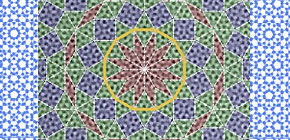
In pursuit of quasicrystal properties that are not seen in crystals
Dirac fermion quasicrystals realized using a novel method
A group of researchers from Osaka University, Sungkyunkwan University, NYU Shanghai, Harvard University, and the Korea Institute for Advanced Study succeeded in quasicrystallization of a relativistic Dirac fermion by modulating Dirac electrons in a single-layer graphene by another single-layer graphene rotated exactly 30°.
Quasicrystal is the ordered state between crystalline and amorphous with a structure that is ordered but not periodic. Crystals have a rotational symmetry. When rotating a crystal, the same structure appears every 60 degrees. The rotational symmetries of a crystal are limited to 2-, 3-, 4-, and 6-fold symmetry. On the other hand, quasicrystals have 5-, 8-, 10-, and 12-fold symmetry, which are impossible in a crystal, so while quasicrystals have no periodicity, they do have rotational symmetries. AlNiCo (Al-Ni-Co) alloys are common examples of quasicrystalline systems.
Graphene is a two-dimensional honeycomb crystal of hexagonally-arranged carbon. In this study, a dodecagonal quasicrystalline order was realized by epitaxial growth of twisted bilayer graphene (TBG) rotated exactly 30°. By observing the inside of an electron by angle-resolved photoemission spectroscopy (ARPES), the electronic structure of 12-fold symmetry, which is peculiar to quasicrystals, was clarified.
Electrons in graphene behave as massless “relativistic Dirac particles.” The graphene quasicrystal realized in this study can be called “Dirac quasicrystal,” a new physics system. The discovery of quasicrystals in 1984 was a great discovery that defied prior conventional wisdom on crystallography. Most matter with the structure of quasicrystals had been limited to alloys with a specific elemental composition.
The graphene quasicrystal in this study, realized by using two 2-dimensional crystals rotated to a specific degree with respect to each other, will expand the paradigm of quasicrystals. It is anticipated that special electrical and thermal properties of quasicrystals due to their unique geometric structures will be discovered. Previous studies show that quasicrystals have a far higher electrical resistivity than crystals with the same elemental composition and that they have low coefficients of friction, but most of their properties have been unknown. This group’s achievements will expand the scope of quasicrystals and lead to the discovery of properties not found in ordinary matter.
Abstract
Quantum states of quasiparticles in solids are dictated by symmetry. We experimentally demonstrate Dirac electrons in a two-dimensional quasicrystal without translational symmetry. A dodecagonal quasicrystalline order was realized by epitaxial growth of twisted bilayer graphene rotated exactly 30°. The graphene quasicrystal was grown up to a millimeter scale on an SiC (0001) surface while maintaining the single rotation angle over an entire sample and was successfully isolated from a substrate, demonstrating its structural and chemical stability under ambient conditions. Multiple Dirac cones replicated with the 12-fold rotational symmetry were observed in angle-resolved photoemission spectra, which revealed anomalous strong interlayer coupling with quasi-periodicity. Our study provides a way to explore physical properties of relativistic fermions with controllable quasicrystalline orders.
Figure 1. Bilayer graphene stacked at 30 degree. (Bottom) Quasicrystal tiling in the 30-degree stacked bilayer graphene.
Figure 2
The article, "Dirac electrons in a dodecagonal graphene quasicrystal" was published in Stem Cell Reports, https://10.1126/science.aar8412
Related link

